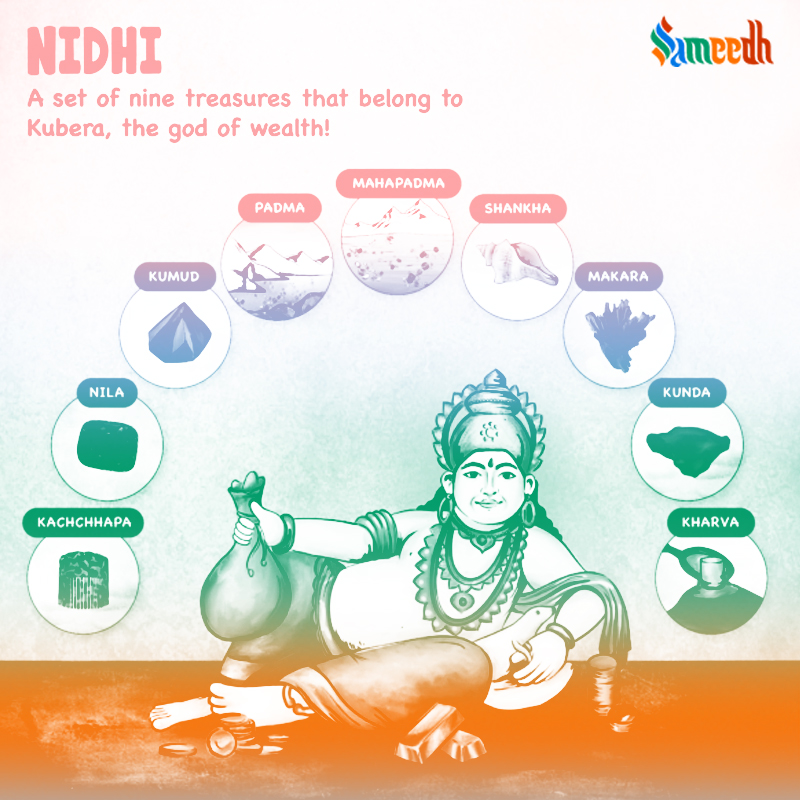In Hinduism, the concept of Nidhi refers to various types of treasures or wealth associated with deities or divine beings. While the specific number of Nidhis may vary in different traditions and interpretations, there are commonly mentioned nine Nidhis.

In Hinduism, Nidhi refers to wealth or treasure. There are nine such treasures out of many which lie in the possession of Lord Kuber, the god of wealth and finance. Nidhi is also synonymous with assets and can be equated with other Nidhis as a form of measurement and comparison too. To attain such immense wealth, one has to resort to constant and deep spiritual practices to be blessed with such riches.
Lord Hanuman is believed to have these nine Nidhis along with Eight Siddhis which were bestowed upon him as a boon by Sita, Ram’s wife.
According to Hindu mythology, these nine treasures represent the nine primary energies or forces of the universe, and they are said to be guarded by the nine celestial gods known as the Navagraha. The Nav Nidhi are often depicted in Hindu art and literature as symbols of wealth, prosperity, and good fortune.
Padma Nidhi
Padma is a lotus flower. This Nidhi is said to stay with an individual during reincarnations. The person with this Nidhi is deemed to have earned it in accordance with Sattva Guna. It is the quality of truth, purity, cleanliness and ethics. The wealth procured too is Sattvik and can be passed on to all further generations to come. They majorly have assets in the form of gold and silver. People with Padma Nidhi also donate to charity often.
Mahapadma Nidhi
This is similar to Padma Nidhi where maha translates to huge, meaning a big lotus. Mahapadman Nidhi too is Sattvik but it stays with only the immediate seven generations to come. This Nidhi too motivates a person to share and donate his acquisition.
Nila Nidhi
This Nidhi consists of Sapphire or gemstones. It is present with both Sattva and Rajas gunas. Rajas is the quality of passion. Ideally, this sort of possessions are gathered through business or trading. Nila Nidhi can be inherited by the next three generations. Although the prosperity acquired is honourable, due to the presence of Rajas, a factor of cunning too can be involved in money making.
Shankha Nidhi
A conch shell signifies this Nidhi. This person is recognised as a selfish being who solely cares for himself. He goes on earning great wealth, but only spends it for his own purposes and needs, not even for that of his family’s.
Makara Nidhi
Crocodile is the symbol of this Nidhi which is governed by Tamas Guna, the quality of laziness, darkness and dullness. The person with this Nidhi is known for collecting weapons and ammunition. As Tamas presides here, the person radiates dark or evil characteristics, he also meddles with authoritative powers or kingship. The death of people with Makara Nidhi too happens with weapons.
Kachchhapa Nidhi
Kachchhapa means tortoise. Just as this animal, the person with this Nidhi accumulates great wealth but protects it under his shell instead of using it. Typically this person is a miser who rarely spends his money even on his own self.
Mukunda Nidhi
Mukund is represented by cinnabar or quicksilver and is ruled by Rajas guna. This Nidhi stays with a person only for one generation. As it lacks Sattva, honesty, the people with this Nidhi are said to have stumbled upon wealth out of the blue which they manage to use up in a lifetime itself.
Nand Nidhi
It is depicted by joy or delight. It is influenced by both Sattva and Rajas guna. People with this Nidhi are believed to have a long life. They often are extremely ambitious and keep progressing in life. But these people also have a regular need of appreciation and hearing praises of themselves.
Kharva Nidhi
Kharva denotes cups or the aspect of countless. This Nidhi is the amalgamation of all other eight Nidhis in small capacities. A Kharva Nidhi individual is shrewd and always on the lookout for ways to procure wealth from others and expand his own luxury.